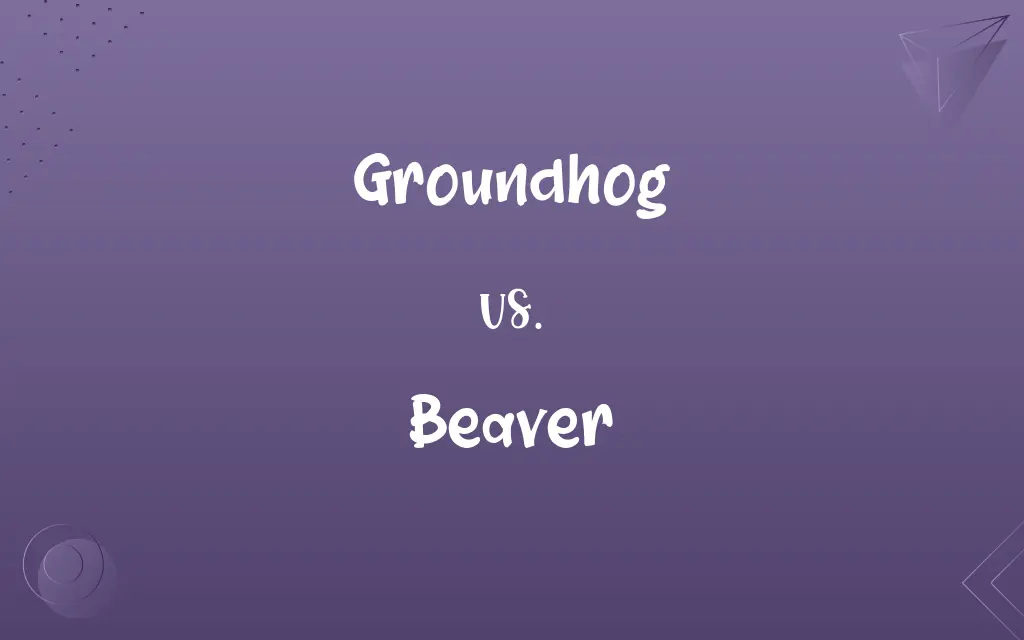Groundhog vs. Beaver: Know the Difference

By Shumaila Saeed || Published on January 1, 2024
Groundhogs are burrowing rodents known for their weather prediction folklore, while beavers are aquatic rodents famous for building dams.

Key Differences
Groundhogs, also known as woodchucks, are primarily land-dwelling rodents known for their burrowing habits. Beavers, in contrast, are aquatic rodents recognized for their dam-building skills in rivers and streams. Both are North American natives but have different habitats and behaviors.
Shumaila Saeed
Jan 01, 2024
The groundhog is famous for its role in the North American tradition of Groundhog Day, where its shadow is said to predict the weather. Beavers do not have such cultural folklore but are notable for their environmental impact, creating habitats that benefit other wildlife. Both have significant roles in their ecosystems and cultures.
Shumaila Saeed
Jan 01, 2024
Groundhogs feed mainly on vegetation such as grasses, fruits, and tree bark. Beavers are also herbivores, but they particularly favor wood, especially the bark and cambium of trees. Both species' feeding habits significantly influence their respective habitats.
Shumaila Saeed
Jan 01, 2024
In terms of physical appearance, groundhogs have sturdy bodies and short legs, suited for digging. Beavers are larger with distinctive flat, paddle-like tails and webbed feet, adaptations for their aquatic lifestyle. Both are well-adapted to their environments through these physical characteristics.
Shumaila Saeed
Jan 01, 2024
Groundhogs typically live in burrows they dig, which include separate chambers for sleeping and waste. Beavers live in lodges they construct from trees and mud, often with underwater entrances for protection. Both animals demonstrate complex behaviors in creating their living spaces.
Shumaila Saeed
Jan 01, 2024
ADVERTISEMENT
Comparison Chart
Habitat
Primarily terrestrial, lives in burrows
Aquatic, builds lodges in waterways
Shumaila Saeed
Jan 01, 2024
Cultural Significance
Known for Groundhog Day tradition
Recognized for dam-building skills
Shumaila Saeed
Jan 01, 2024
Diet
Vegetation, such as grasses and fruits
Woody plants, especially tree bark
Shumaila Saeed
Jan 01, 2024
Physical Characteristics
Sturdy body, short legs for digging
Large body, flat tail, webbed feet for swimming
Shumaila Saeed
Jan 01, 2024
Behavioral Traits
Burrowing with separate chambers
Lodge building with underwater entrances
Shumaila Saeed
Jan 01, 2024
ADVERTISEMENT
Groundhog and Beaver Definitions
Groundhog
Famous for the folklore of predicting the length of winter.
On Groundhog Day, the groundhog saw its shadow, predicting more winter.
Shumaila Saeed
Dec 19, 2023
Beaver
An aquatic rodent known for dam building.
The beaver was busy constructing a dam across the stream.
Shumaila Saeed
Dec 19, 2023
Groundhog
Known for creating extensive burrow systems.
The groundhog's burrows can be quite complex and extensive.
Shumaila Saeed
Dec 19, 2023
Beaver
Recognized for their large, flat tails and sharp teeth.
The beaver used its sharp teeth to gnaw through the wood.
Shumaila Saeed
Dec 19, 2023
Groundhog
A creature that plays a role in its ecosystem as a prey species.
Groundhogs serve as an important food source for many predators.
Shumaila Saeed
Dec 19, 2023
ADVERTISEMENT
Beaver
An animal that creates habitats beneficial for other wildlife.
The beaver's dam created a wetland area that supports diverse wildlife.
Shumaila Saeed
Dec 19, 2023
Groundhog
A North American rodent known for burrowing.
The groundhog emerged from its burrow early in the spring.
Shumaila Saeed
Dec 19, 2023
Beaver
A symbol of industriousness and engineering skills.
The beaver is often admired for its natural engineering abilities.
Shumaila Saeed
Dec 19, 2023
Groundhog
An animal also referred to as a woodchuck.
We spotted a groundhog, or woodchuck, in the backyard.
Shumaila Saeed
Dec 19, 2023
Beaver
Either of two large semiaquatic rodents, Castor canadensis of North America or C. fiber of Eurasia, having thick brown fur, webbed hind feet, a broad flat tail, and sharp incisors used for gnawing bark and felling trees, with which they construct dams and underwater lodges.
Shumaila Saeed
Dec 13, 2023
Groundhog
A reddish brown North American burrowing marmot (Marmota monax), also called the woodchuck. It hibernates in the winter.
Shumaila Saeed
Dec 13, 2023
Beaver
A piece of armor attached to a helmet or breastplate to protect the throat or lower face.
Shumaila Saeed
Dec 13, 2023
Beaver
(backgammon) After being doubled, to immediately double the stakes again, a move that keeps the doubling cube on one’s own side of the board.
Shumaila Saeed
Dec 13, 2023
Beaver
(countable) A semiaquatic rodent of the genus Castor, having a wide, flat tail and webbed feet.
Shumaila Saeed
Dec 13, 2023
Beaver
(countable) A hat, of various shapes, made from a felted beaver fur (or later of silk), fashionable in Europe between 1550 and 1850.
Shumaila Saeed
Dec 13, 2023
Beaver
(North American) Beaver pelts as an article of exchange or as a standard of value.
Shumaila Saeed
Dec 13, 2023
Beaver
Beaver cloth, a heavy felted woollen cloth, used chiefly for making overcoats.
Shumaila Saeed
Dec 13, 2023
Beaver
A move in response to being doubled, in which one immediately doubles the stakes again, keeping the doubling cube on one’s own side of the board.
Shumaila Saeed
Dec 13, 2023
Beaver
Senseid|en|member of the youngest wing of the Scout movement}} {{alternative case form of Beaver.
Shumaila Saeed
Dec 13, 2023
Beaver
A hat, formerly made of the fur of the beaver, but now usually of silk.
A brown beaver slouched over his eyes.
Shumaila Saeed
Dec 13, 2023
Beaver
Beaver cloth, a heavy felted woolen cloth, used chiefly for making overcoats.
Shumaila Saeed
Dec 13, 2023
Beaver
A person who works enthusiastically and diligently; - used especially in the phrase eager beaver.
Shumaila Saeed
Dec 13, 2023
Beaver
That piece of armor which protected the lower part of the face, whether forming a part of the helmet or fixed to the breastplate. It was so constructed (with joints or otherwise) that the wearer could raise or lower it to eat and drink.
Shumaila Saeed
Dec 13, 2023
Beaver
A movable piece of armor on a medieval helmet used to protect the lower face
Shumaila Saeed
Dec 13, 2023
Beaver
Large semiaquatic rodent with webbed hind feet and a broad flat tail; construct complex dams and underwater lodges
Shumaila Saeed
Dec 13, 2023
Beaver
Known for their impact on the environment and ecosystems.
Beavers play a crucial role in shaping aquatic ecosystems.
Shumaila Saeed
Dec 19, 2023
Repeatedly Asked Queries
What is a beaver?
A beaver is an aquatic rodent known for building dams and lodges.
Shumaila Saeed
Jan 01, 2024
Can groundhogs be found in urban areas?
Yes, groundhogs are adaptable and can be found in both rural and urban environments.
Shumaila Saeed
Jan 01, 2024
Do beavers hibernate?
Beavers do not hibernate, but they may become less active during the winter when ice covers their pond.
Shumaila Saeed
Jan 01, 2024
How do groundhogs predict the weather on Groundhog Day?
Groundhogs don't predict the weather; Groundhog Day is a traditional superstition rather than a scientific prediction.
Shumaila Saeed
Jan 01, 2024
What is the purpose of a beaver's dam?
Beaver dams help regulate water flow, create wetland habitats, and provide a safe environment for raising their young.
Shumaila Saeed
Jan 01, 2024
What is a groundhog?
A groundhog is a burrowing rodent native to North America.
Shumaila Saeed
Jan 01, 2024
Do groundhogs hibernate?
Yes, groundhogs hibernate during the winter months.
Shumaila Saeed
Jan 01, 2024
How long do groundhogs live?
Groundhogs typically live around 6 years in the wild.
Shumaila Saeed
Jan 01, 2024
What do beavers eat?
Beavers primarily eat tree bark, cambium, and aquatic plants.
Shumaila Saeed
Jan 01, 2024
Are groundhogs the same as beavers?
No, groundhogs and beavers are different animals with distinct characteristics.
Shumaila Saeed
Jan 01, 2024
Are beavers social animals?
Yes, beavers live in family groups called colonies and work together to build and maintain their structures.
Shumaila Saeed
Jan 01, 2024
Can beaver dams cause flooding issues for humans?
While beaver dams can impact local water flow, they generally do not cause significant flooding issues for humans when managed properly.
Shumaila Saeed
Jan 01, 2024
What is the scientific name for a groundhog?
The scientific name for a groundhog is Marmota monax.
Shumaila Saeed
Jan 01, 2024
Do groundhogs pose any agricultural or garden-related problems?
Groundhogs are known to dig burrows and may occasionally damage gardens and crops.
Shumaila Saeed
Jan 01, 2024
Are beavers found outside of North America?
Yes, beavers are found in North America, Europe, and Asia, with various species adapted to different regions.
Shumaila Saeed
Jan 01, 2024
Are beavers known for their sharp teeth?
Yes, beavers have strong, chisel-like incisor teeth that they use for cutting trees and building dams.
Shumaila Saeed
Jan 01, 2024
Are beavers good for the environment?
Beavers play a vital role in shaping ecosystems and enhancing biodiversity through their dam-building activities.
Shumaila Saeed
Jan 01, 2024
Share this page
Link for your blog / website
HTML
Link to share via messenger
About Author
Written by
Shumaila SaeedShumaila Saeed, an expert content creator with 6 years of experience, specializes in distilling complex topics into easily digestible comparisons, shining a light on the nuances that both inform and educate readers with clarity and accuracy.








































































